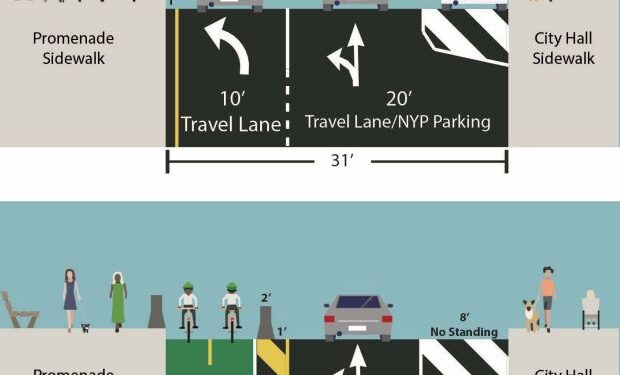It could soon become easier to roll on to the Brooklyn Bridge bike lane.
The city Department of Transportation wheeled out a proposal Wednesday to expand the Manhattan-side entryway to the bridge’s bike path — a project that would be contingent on scrapping a car lane and relocating several parking spots reserved for journalists working at City Hall.
Currently, the bike lane is accessed on the Manhattan side via a small promenade where pedestrians also enter and exit the bridge’s footpath. The mixed use of the promenade has resulted in bicyclists often having to weave through crowds of pedestrians to get on the bike lane.
Amid complaints about that congestion, Transportation Department officials proposed at a Manhattan Community Board 1 meeting Wednesday evening to make the bridge’s bike lane more easily accessible by building a new entryway ramp that would snake around the pedestrian promenade.

Constructing the new ramp would come at a cost to motorists.
Transportation Department slides presented at the meeting and shared with the Daily News show the new ramp would be built in what is currently the left turning lane on Centre St. that motorists use to drive on to the Brooklyn Bridge. In addition to removing that car lane and turning the two-lane stretch into a single file, the proposal calls for removing about eight parking spaces on the right-hand side of Centre St. that are set aside for media organizations and primarily used by TV journalists who cover City Hall.
Under the plan, the eight media parking spots would be moved around the corner to a section of Chambers St. near the Tweed Courthouse that is currently a no-standing zone.
Transportation Department spokesman Vincent Barone acknowledged turning the Centre St. stretch into a single lane would result in traffic turning onto the bridge taking an average of 2.6 seconds, up from the current 1.5 seconds, citing an internal agency study. Barone said the redesign would still be able to accommodate all current traffic volumes and argued the plan would improve the bridge’s bike lane, which opened to the public in September 2021 under ex-Mayor Bill de Blasio.
“Our Brooklyn Bridge bike lane represented a historic improvement for cyclists and pedestrians, directly leading to a surge in bike ridership over the span,” Barone said, noting that ridership on the bridge has increased from an average of 2,652 daily trips in 2021 to 4,769 in 2023. “We look forward to building on this success by upgrading the approach on the Manhattan side to reduce conflicts between cyclists and pedestrians, and improve safety, as they access the bridge.”
Transportation Department officials weren’t immediately able to say how soon construction could begin on the proposed bike lane access expansion. They said they’ll collect public feedback on the bid and then determine next steps.

Sam Schwartz, a former Transportation Department chief engineer and traffic expert, said an extra second delay won’t be especially cumbersome for drivers.
“If DOT’s analysis is correct that the added delay is about a second, then the safety improvements for bike riders and traffic in general is worth it,” said Schwartz, who became known as “Gridlock Sam” after popularizing the traffic jam phrase in the 1980s.
Some motorists have complained car traffic slowed on the Brooklyn Bridge after the bike lane’s inauguration.
A study from the analysis firm INRIX found average car speeds on the Manhattan-bound side of the bridge, where the bike path occupies what used to be a third car lane, dropped to 19.5 mph in March 2022, down about 28% from the 27 mph averaged in March 2019.
The bridge’s Brooklyn-bound span — which didn’t lose a lane as part of the bike lane redesign — saw a much smaller reduction in speeds, falling 1.2 mph, or 6%, from 19.8 mph in March 2019 to 18.6 mph in March 2022, according to the study.
Originally Published:







